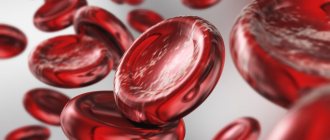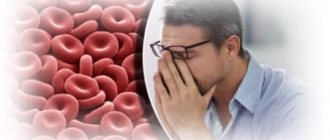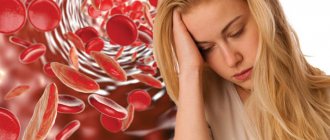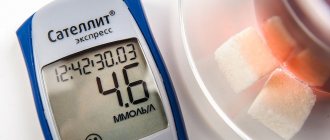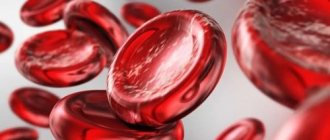Hemoglobin level is an important indicator of a man’s health, and its decrease is a good reason to see a doctor. After all, this protein performs a number of vital functions, including ensuring tissue respiration. Therefore, when its concentration in the blood decreases, changes in well-being of varying degrees occur, and in severe cases, low hemoglobin can cause the development of serious complications.
What is hemoglobin
Hemoglobin is a complex protein containing iron. Its main task is to add oxygen diffusing into the blood from the lungs and distribute it throughout the body. Giving oxygen to cells, hemoglobin attaches carbon dioxide formed by them in the process of vital activity. Then getting through the bloodstream to the lungs, it gives it away, again making room for oxygen. This is how gas exchange and tissue respiration occur. But, in addition, hemoglobin is involved in maintaining the acid-base balance, in DNA synthesis, and in the occurrence of a number of redox reactions.
To synthesize hemoglobin, the body uses iron, which comes from food and accumulates in the form of ferritin in the liver, lungs, and spleen. There is also a small amount of iron present in the intestinal mucosa. If the diet does not meet the body's iron needs, ferritin is activated. This helps maintain normal hemoglobin levels and organ function. But with prolonged deficiency, its reserves are depleted, and the concentration of hemoglobin decreases.
In men, critically low hemoglobin levels are rare, since they, unlike women, do not experience regular physiological bleeding. For the same reason, the increase in hemoglobin in men occurs faster and more effectively. But if left untreated, there is a serious risk of complications, especially if you have bad habits:
- thrombosis;
- myocardial infarction;
- stroke;
- decreased immunity;
- deterioration of cognitive functions (memory, attention);
- hypoxic coma.
Often, when low hemoglobin persists for a long time, the presence of chronic fatigue syndrome is observed.
Anemia in older people
Using these standards, it is estimated that about 4% of men and 8% of women living in the United States fall under this definition. Among patients who go to hospitals for medical care, this percentage is much higher. This is especially noticeable among middle-aged and elderly patients, where this figure ranges between 8 and 44%. In most cases, anemia is a manifestation of some other disease. Therefore, even if the anemia is mild and the patient does not experience symptoms, investigation of its causes is absolutely necessary in order to identify the underlying disease causing it. Anemia among older people has been repeatedly interpreted as a normal phenomenon associated with aging. Actually this is not true. In most healthy older adults, hemoglobin and hematocrit remain within normal limits. Another reason is the fact that in 80 percent of older people who suffer from anemia, the cause can be identified. This article will discuss four types of anemia that are most common among older adults living in the United States. Symptomatology of anemia First of all, it should be noted that the symptoms of anemia are not specific to one or another type of anemia. They are a compensatory response to tissue hypoxia and usually develop when hemoglobin falls below 7 gm/dL, although symptoms may occur in patients with higher hemoglobin levels. This usually occurs against the background of chronic heart and lung diseases, as well as in cases where anemia has developed very quickly (as, for example, as a result of bleeding). The most common complaints of patients with anemia are weakness, increased fatigue, headache, shortness of breath, and increased drowsiness. Patients with coronary heart disease may experience chest pain and loss of consciousness. Patients may also complain of dizziness, tinnitus, loss of libido, and flashing spots in the eyes. As a rule, these symptoms appear gradually due to the physiological abilities of the body to adapt to new conditions. In many cases, these symptoms are not perceived as something worthy of special attention, and are “written off” as an aging organism. The most important element in the diagnosis of a particular disease, including anemia, is the collection of anamnesis and examination of the patient. In Western medicine, significant attention is paid to this, despite the availability of laboratory tests. When collecting anamnesis, the patient needs to ask a number of questions, the answers to which can serve as a significant clue to establishing the correct diagnosis. For example, jaundice and dark urine in a patient without liver disease may suggest hemolysis underlying the anemia. Weight loss may be caused by the presence of a malignant tumor. Paresthesia in the hands and feet occurs with deficiency of vitamin B12 and folic acid. It is very important to ask the patient about possible exposure to chemicals, such as insecticides, solvents, paints. Many chemicals can have a significant effect on the process of hematopoiesis, suppressing the bone marrow. When gathering information about a potential source of bleeding leading to anemia, it is very important to inquire about changes in bowel movements and the presence of blood in the stool. Black, tar-like stool is an indicator of bleeding from the gastrointestinal tract, which may be due to gastric or duodenal ulcers, as well as erosive esophagitis. The presence of bright red blood in the stool is most often combined with hemorrhoids, diverticulosis or colon tumors. An interpretation of the test results used to make the initial diagnosis of anemia is presented in Table 1. Anemia of Chronic Disease Anemia of chronic disease is most common among older Americans. Numerous diseases lead to this condition. Among them, the most common are infections, tumors, autoimmune diseases, and chronic kidney diseases. The pathogenesis is based on a combination of several factors. Firstly, the lifespan of red blood cells is slightly reduced, secondly, sequestration of iron occurs in the cells of the reticuloendothelial system, which cannot be effectively utilized by the body and, finally, the level of erythropoietin is not high enough relative to the degree of anemia. Examination of the blood smear usually reveals normal red blood cells. Only in some cases hypochromia is observed. Microcytosis occurs in approximately one third of patients. Serum iron, transferrin and serum iron binding capacity (IBC) concentrations are quite low in most patients. At the same time, ferritin concentrations, which is an indirect indicator of inflammation, remain normal or elevated. The main distinguishing feature of ACD from iron deficiency anemia is normal iron reserves in the body, which can be confirmed by a bone marrow biopsy. It is believed that all these changes occur under the influence of cytokines such as interleukin-1, tumor necrotic factor, alpha, beta and gamma interferons. In recent years, another mediator involved in iron metabolism, called hepcidin, has been discovered. In the presence of an inflammatory process, the concentration of hepcidin can increase 100 times. hepcidin is secreted in response to increased iron stores in the liver. In this case, hepcidin blocks the absorption of iron from the gastrointestinal tract and stimulates the uptake of iron molecules by macrophages, which are part of the reticuloendothelial system. It should be noted that anemia of chronic diseases is usually not severe. Its degree correlates with the severity of the chronic disease that causes it. Only in fairly rare cases does hemoglobin drop significantly below 10 g per dl (100 g per L). Treatment of ACD should begin with identifying and treating the underlying disease that caused this condition. Iron supplements are not effective for the treatment of ACD. Synthetic erythropoietin is the main treatment used today. Its main task is to replace endogenous erythropoietin, which is produced insufficiently in people with ACD. In this regard, it would be useful to measure the concentration of endogenous erythropoietin before starting treatment. If it exceeds 500 mU/ml, the likelihood of effective use of synthetic erythropoietin is low. In other cases, subcutaneous injections of erythropoietin are recommended at a dosage of 100–150 U/kg three times a week. In recent years, weekly subcutaneous injections at a dose of 40,000 U have become increasingly common. If hemoglobin does not increase after 12 weeks of treatment, erythropoietin injections should be discontinued. Darbepoetin alfa is a long-acting drug. It can be used at a dosage of 100 µg or 200 µg once every two weeks. Iron deficiency anemia Iron deficiency anemia occurs when the body's need for iron exceeds the iron intake in the diet. A person should consume at least 1 g of iron per day to balance the body's natural loss of iron. As iron stores in the body decrease, anemia develops. Iron deficiency anemia is the second most common among middle-aged and older adults in the United States. The most common cause of this condition is directly related to bleeding from the gastrointestinal tract. In the vast majority of cases, this bleeding is very slow, almost imperceptible to the naked eye. The most common causes of such bleeding are gastritis, gastric and duodenal ulcers, diverticulosis, intestinal angiodysplasia and colon cancer. In the United States, a fairly large percentage of ulcers and gastritis are caused by the use of nonsteroidal anti-inflammatory drugs, which can be purchased without a prescription. Older people often abuse these drugs, which they use as pain relievers to treat musculoskeletal conditions (eg, osteoarthritis). Less commonly, the cause of anemia can be chronic bleeding from the genitourinary system, hemophthisis, and blood clotting diseases. Of course, iron deficiency anemia can result from insufficient iron intake in the diet. In America, as in other countries of the world, a large number of older people have a fairly monotonous diet for one reason or another, and therefore it usually takes several years before clinical symptoms appear. Treatment Iron tablets are used as the main treatment for iron deficiency anemia. It should be noted that the reaction of the bone marrow to the iron obtained from these preparations has its limits. It has been found that the bone marrow does not respond with faster red blood cell production and hemoglobin synthesis to iron doses greater than 20 mg per day. It is necessary to take into account the fact that the absorption of iron in the jejunum is influenced by a number of factors. Among the factors that increase iron absorption are ascorbic acid. Substances such as calcium, cellulose, and foods such as tea, coffee and wine slow down this process. In addition to this, it should be borne in mind that the process of iron absorption is directly related to the degree of iron deficiency in the body. In a healthy adult, only 5 to 10 percent of the iron consumed in food will be absorbed. At the same time, this figure can increase by 3–5 times in the event of a significant lack of iron in the body. In practice, there are two types of iron supplements - ferrous gluconate, which is usually available in two dosages (300 and 325 mg), and ferrous sulfate in the most common dosage of 325 mg. To achieve results, these drugs need to be taken 3-4 times a day. You should expect an increase in hemoglobin levels of 1 g per dL (10 g per L) every 2-3 weeks of regular medication use. However, complete restoration of iron reserves in the body can take up to four months after hemoglobin has returned to normal. The second way to replenish iron reserves in the body is its parenteral administration using intravenous infusion. In cases of malabsorption, intolerance to tablet forms of iron, chronic bleeding from the gastrointestinal tract that cannot be localized or eliminated, these drugs acquire a primary role. Until recently, iron dextran was the only drug from this group. Using this drug, it was possible to administer large doses (200 to 500 mg) into the body at one time. The most serious side effect of this drug was anaphylactic shock in a very small percentage of patients (0.61%). The more common complications, along with headache, were muscle and joint pain, which usually occurred in the first 48 hours after using the drug. Nonsteroidal anti-inflammatory drugs have been very effective in relieving these symptoms. In the period 1999–2000, two new drugs for intravenous iron administration appeared on the American market: Sodium ferric gluconate and iron sucrose, which were much safer than their predecessors. When using them, the risk of anaphylaxis is estimated in hundredths of a percent. The first drug is administered at a dose of 125 mg per week for 8 weeks. The second is administered at a dose of 200 mg, a total of 5 doses over two weeks. Blood transfusions are also a means of treating anemia, including iron deficiency. Typically, this method is used to treat patients with severe symptoms, such as shortness of breath and severe weakness. In the presence of coronary artery disease, some experts advise that even patients who are not experiencing any symptoms receive blood transfusions if their hemoglobin is below 10 g per dL (100 g per L). There is no generally accepted point of view on this issue yet. In our opinion, this is not at all necessary, provided that the patient feels well. Anemia Associated with Vitamin B12 Deficiency Vitamin B12 deficiency is found in 5–10% of older adults, but vitamin B12 deficiency is actually much more common in this population. And only about 60% of people with low levels of this vitamin develop anemia. There are several features of this condition that create significant difficulties in establishing a diagnosis. First, neurological symptoms may develop much earlier than anemia. Speaking about neurological symptoms, it is necessary to mention sensitivity disorders (especially vibration and body position), hyporeflexia, and muscle weakness. As vitamin B12 deficiency progresses, ataxia, spasticity, and “socks and gloves”-like sensory disturbances may also develop. Second, there is significant variation in the microscopic appearance among patients with vitamin B12 deficiency. The classic description of macrocytes and megaloblasts is not always what we see in real life under a microscope. There are often cases when this anemia is normocytic and even microcytic. Third, the level of vitamin B12 in the blood plasma does not reflect the potential deficiency of this vitamin in tissues. About a third of patients whose vitamin B12 levels were at the lower limit of normal suffer from anemia and neurological symptoms. A more reliable indicator of the presence of vitamin B12 deficiency is the levels of methylmalonic acid and homocysteine in the blood serum. Vitamin B12 is a cofactor in the metabolism of these substances. Therefore, when it is deficient, the level of these compounds in the blood is increased. At the same time, normal concentrations of methylmalonic acid and homocysteine practically eliminate vitamin B12 deficiency. Causes of Vitamin B12 Deficiency The most common cause is decreased intestinal absorption of vitamin B12. Pernicious anemia is a clear illustration of this phenomenon. In the case of pernicious anemia, autoimmune destruction occurs in the parietal cells of the stomach, which produce intrinsic factor, which is an integral part of the absorption process of vitamin B12. Decreased absorption of this vitamin has also been noted in patients undergoing gastrectomy (10 to 30%). In patients with small intestinal diseases, such as increased bacterial growth in the small intestine, this condition is also not uncommon. Vitamin B12 deficiency as a result of inadequate dietary intake is extremely rare these days and is observed mainly in vegetarians. In the recent past, the Schilling test was used to diagnose vitamin B12 deficiency. Currently, it has lost its clinical significance and is practically not used. High doses of vitamin B12 correct deficiency regardless of its cause. Treatment Vitamin B12 deficiency is treated by replenishing its reserves in the body. For this purpose, a tablet form is used in a dose of 1000 to 2000 mg or intramuscular injections of the drug. In the case of intramuscular injections, the standard dose is 1000 mg per day for 7 days, then once a month. The effectiveness of treatment is determined by an increase in the number of reticulocytes in the blood. As a rule, this occurs a week after the start of treatment. Anemia Caused by Folate Deficiency Unlike vitamin B12 deficiency, folate deficiency usually results from inadequate dietary intake. The human body has sufficient reserves of folic acid for only 4–6 months. Classic anemia associated with folic acid deficiency is macrocytic. However, about a quarter of patients with folate deficiency have normocytic anemia. 90% of patients with folic acid deficiency have elevated homocysteine levels. However, the level of methylmalonic acid remains normal, which is an important factor in the differential diagnosis with anemia caused by vitamin B12 deficiency. An interesting fact is that by treating anemia associated with folic acid deficiency, anemia caused by vitamin B12 deficiency improves. However, there is no improvement in neurological symptoms associated with vitamin B12 deficiency. Treatment for this anemia is quite simple - folic acid 1 mg per day. Figure 1 provides an algorithm that will help systematize the process of establishing the correct diagnosis in patients with anemia
References 1. Smith, D. (2000, October 1). Anemia in the Elderly. American Family Physician. Retrieved September 15, 2008, from https://www.aafp.org/afp/AFPprinter/20001001/1565.html 2. Johnson, L. E. (2007, April). Vitamin B12. The Merck Manual Online Medical Library. Retrieved September 13, 2008, from https://www.merckmedicus.com/pp/us/hcp/framemm.jsp?pg=www. merck. com/mmpe/index.html 3. Conrad, M. E. (2008, March 11). Anemia. eMedicine. Retrieved September 15, 2008, from https://www.emedicine.com/MED/topic132.htm 4. Killip, S., Bennett, J. M., & Chambers, M. D. (2007, March 1). Iron Deficiency Anemia. American Family Physician. Retrieved September 14, 2008, from https://www.aafp.org/afp/20070301/671.html
Reasons for decreased hemoglobin levels
The main reasons for a decrease in hemoglobin levels in the blood in men are:
- reduction in the amount of iron entering the body;
- disturbances in the absorption and transport of iron throughout the body;
- a decrease in the number of red blood cells as a result of a violation of their production by the bone marrow or a shortening of life due to various circumstances.
In this case, most often a decrease in hemoglobin is due to iron deficiency in the body. The fact is that the absorption of this microelement from food is limited. Even with proper nutrition, no more than 1-1.5 mg can be absorbed per day, and if there are errors in the diet, the amount of iron entering the body cannot cover the need for it. In such cases, iron depots in the form of ferritin are used to maintain normal life functions. But its reserves are limited, and therefore, when they are depleted, the intensity of bone marrow erythropoiesis decreases. As a result, the number of red blood cells, as well as the level of hemoglobin, decrease, which indicates the development of anemia and is accompanied by the appearance of characteristic symptoms.
Thus, the causes of low hemoglobin in men can be:
- malnutrition;
- insufficient consumption of foods that are sources of iron:
- adherence to a vegetarian diet;
- diseases of the gastrointestinal tract;
- severe bleeding during injuries, operations, including hidden ones (observed with peptic ulcers of the stomach and duodenum, kidney pathologies, pulmonary siderosis, etc.);
- haemorrhoids;
- malignant tumors;
- chronic intoxication;
- vasculitis;
- systemic scleroderma;
- systemic lupus erythematosus;
- helminthiasis;
- cystic fibrosis;
- rheumatoid arthritis, etc.
Statistics show that men are more likely than women to have gastrointestinal diseases caused by Helicobacter pillory, which leads to impaired absorption of iron in the intestines and a decrease in hemoglobin.
Both adults and children
With iron deficiency anemia, the balance is disturbed: the loss of iron in the body exceeds its absorption. This happens in children during periods of rapid growth (in the second year of life and adolescence) or due to infection with worms. Anemia is a frequent companion of pregnant and lactating women, whose iron needs increase sharply - after all, they have to “share” it with the child.
But the most common cause of iron deficiency in adults is frequently recurring small bleeding (from 5-10 ml per day). They can be caused by a variety of diseases: from bleeding ulcers and hemorrhoids to stomach cancer. In women, the main cause of iron deficiency is uterine bleeding (caused by endometriosis or other gynecological diseases) and heavy menstruation; in men, bleeding from the gastrointestinal tract.
Often we rob ourselves: fasting days, independent diets are a very short path to iron deficiency.
Symptoms
The severity of symptoms largely depends on the level of hemoglobin: the lower it is, the more severe the anemia. Therefore, in mild cases, men may not notice changes in their well-being or not attach importance to them, since they are little expressed. In such situations, periodic weakness or increased fatigue may occur, but many attribute this to stress, age and other life circumstances. With a further decrease in hemoglobin, the situation becomes more complicated, the existing symptoms become more intense, and others appear.
Sometimes even a decrease in hemoglobin to 90 g/l is asymptomatic.
In general, a decrease in hemoglobin levels in men may appear:
- drowsiness, weakness, decreased performance;
- shortness of breath, which initially occurs due to physical exertion;
- feeling of heartbeat;
- dizziness that can lead to loss of consciousness;
- pallor of the skin and mucous membranes;
- increased irritability, aggressiveness;
- headaches of varying degrees of intensity;
- decreased appetite;
- increased brittleness of nails, the appearance of white spots and bumps on them;
- perversion of taste preferences with the emergence of a desire to eat inedible food, in particular raw meat, chalk, clay;
- developing an addiction to the smells of acetone, gasoline, perfume, etc.;
- ringing in the ears, flickering of spots before the eyes.
A symptom of decreased hemoglobin that is typical for men may be impaired erectile function.
Interesting
If you smoke a lot, you may have anemia, even though a blood test shows normal hemoglobin levels. This happens because the carbon monoxide contained in cigarettes combines with hemoglobin and forms its special form. Such hemoglobin is not able to carry oxygen. And to make up for its deficiency, the body increases the production of hemoglobin, its level is high, but this is of little use. Therefore, abroad, for example, the hemoglobin level of smokers is calculated depending on the number of cigarettes smoked per day.
Diagnostics
If the symptoms described above appear, especially if this is accompanied by the presence of factors predisposing to a decrease in hemoglobin, you should take a general blood test and consult a physician with its results. To confirm anemia, a repeat clinical blood test is usually prescribed. This eliminates the possibility of mistakes being made in the laboratory.
If a decrease in hemoglobin levels is confirmed, treatment for anemia is immediately prescribed. And in parallel with this, a comprehensive examination of the body is carried out in order to identify the causes of its development. This is especially important in cases where there are no obvious prerequisites for this, for example, having undergone surgery in the recent past, injuries with large blood loss, etc. For this, the following may be prescribed:
- blood chemistry;
- stool test for occult blood;
- colonoscopy;
- fibrogastroduodenoscopy;
- Ultrasound of the abdominal organs and kidneys.
How to increase low hemoglobin
Even a slight decrease in hemoglobin levels requires treatment. Otherwise, the man’s well-being will progressively deteriorate. Therefore, from the moment a general blood test is performed and low hemoglobin levels are established, it is necessary to make adjustments to the daily diet and start taking iron-containing medications. It is impossible to cope with the problem only by changing the diet and increasing the amount of iron sources in the body, since at best, as much of this trace element is absorbed from food per day as is consumed. This will not allow the formation of the necessary depots and eliminate the risk of re-development of anemia in the near future.
It is imperative that in combination with the treatment of anemia, therapy for the disease that provoked its development is prescribed. Accordingly, it will be strictly specific in each individual case.
Nutrition correction
With low hemoglobin, men are advised to increase the amount of iron-rich foods in the daily menu, as well as those containing folic acid, vitamin B12 and ascorbic acid, as they increase the quality of its absorption. These include:
- beef tongue, liver;
- white chicken, turkey, veal;
- various seafood, as well as red and black caviar;
- buckwheat, rice;
- leafy greens, cabbage, broccoli, green beans, spinach;
- legumes;
- pumpkin, tomatoes, beets;
- berries, especially black currants, blueberries, cranberries;
- fruits, in particular pomegranate, persimmon, dried apricots;
- peanut.
But when drawing up a menu, it is worth taking into account the peculiarities of iron absorption. So, you should not combine meat dishes with pasta, bread and cereals. They are recommended to be consumed with vegetable side dishes. It is also necessary to consume fermented milk products and nuts separately from other meals.
How to “read” blood tests correctly?
To make sure that the cause of deterioration in health is a lack of iron, you need to take a detailed blood test. Now there are many different laboratories where this can be done.
Article on the topic
Dear, useless, yours. Tests you shouldn't spend money on
Standards may vary. For a man, the norm of hemoglobin is 130-160 g/l of blood, for a woman - 120-140 g/l.
— If a man’s hemoglobin is reduced even slightly, say, to 120-110 g, then this is already a red flag. Even if he does not experience fatigue and has no other symptoms of anemia,” Dobretsova emphasizes, “Reduced hemoglobin may indicate the presence of a polyp, erosion or stomach ulcer. Therefore, you need to go to a gastroenterologist and do a gastrocolonoscopy. There may also be concerns that low hemoglobin is a sign of intestinal or stomach cancer, so this is not something to joke about. With such a result, it is also worth visiting an andrologist.
Women often attribute the lack of hemoglobin to monthly blood loss. But the problem may not only be in the menstrual cycle.
— In a woman, a reduced hemoglobin level may also indicate the presence of polyps, erosion or oncology, so there is no need to delay going to the doctor. Be sure to visit a gastroenterologist and gynecologist, the expert advises.
Well, if a medical examination has ruled out all dangers, reconsider your diet. Get rid of fast food and foods containing dyes and preservatives, eat more lean red meat (beef and lamb) and liver, eat pomegranate, seaweed and pumpkin seeds.
The second important indicator to pay attention to is the mean erythrocyte volume (MCV). Normal MCV is between 80 and 100 femtoliters. If the indicator is reduced (with simultaneously reduced hemoglobin), then most likely the person has iron deficiency anemia. If MCV is normal with reduced hemoglobin, this indicates incipient iron deficiency anemia. It can also signal a chronic disease, such as kidney disease. An elevated MCV is often a sign of a lack of folic acid or vitamin B12.
Yes - to meat, no - to tea. How to deal with anemia? More details
